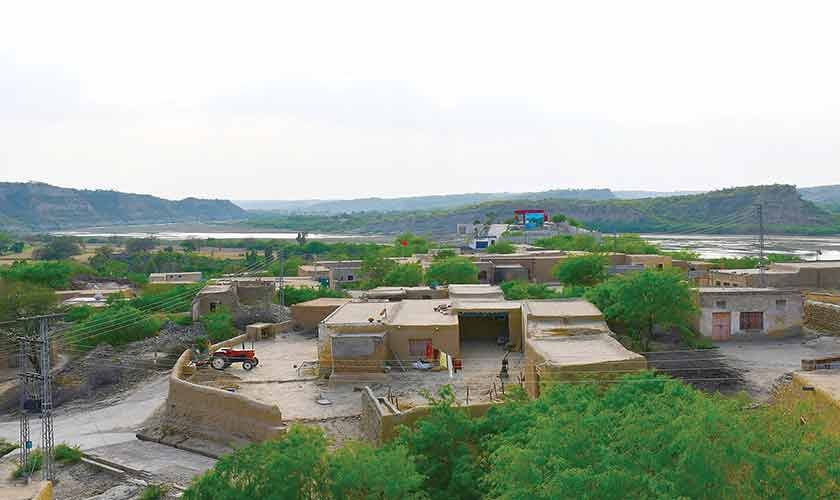**Markhal: A Remote Village of Heritage and Beauty in Talagang Tehsil**
Markhal (also spelled Arkhal) is a remote village located in Chakwals Talagang tehsil, situated on the left bank of the Soan River, approximately 42 kilometres northwest of Talagang town. The village is beautifully nestled between the Soan River and the Qavala Nullah, offering stunning views from the surrounding hills. Mud-plastered houses set against the backdrop of hills and the flowing Soan River make Markhal one of the most picturesque and magnificent villages in the Talagang region.
Despite its natural beauty and rich cultural heritage, Markhal faces significant challenges, including a lack of basic healthcare facilities and the absence of a higher secondary school for girls. The village is notable for its historic shrines, mosque, and intricately carved tombstones, which reflect the skilled craftsmanship of its residents.
—
### Visiting Markhal Village and Exploring Its Heritage
I recently visited Markhal with my friend Tariq Mehmood Malik, a historian and author familiar with the history and heritage of villages in the area. Many of these villages face economic challenges, but Markhal stood out for its architectural and cultural richness.
During our visit, we interviewed several residents about the Jamia Masjid, the shrines, and the tombstones of the village. I learned that the Jamia Masjid Noorani is the oldest mosque in Markhal, likely built around the time the village was founded. Originally a small mosque, it has undergone expansions and renovations over time.
According to Qari Umer Bilal Awan Mairvi, the current pesh-imam of the mosque, the mosque was rebuilt around 1930 using stone quarried from the nearby Markhal hill, specifically from a site known as Kali Watey Wali Jagah. The villagers themselves transported the dressed stone, and two eminent local masons, Mian Muhammad and Baba Gul Muhammad, were responsible for its construction.
—
### Architectural Features of Jamia Masjid Noorani
Stone was the primary building material in pre-Partition buildings throughout villages in Talagang tehsil. Mosques, mansions, and temples alike were built using stone sourced from tributaries of the Soan River.
Though the mosque has been rebuilt relatively recently, some original elements remain intact. The western boundary wall is part of the original structure, built from both small and large dressed and undressed stone slabs crafted by Mistri Mian Muhammad and Mistri Baba Gul Muhammad.
One of the mosque’s original wooden doors also survives, adorned with geometric and floral motifs. Both the lower and upper sections feature geometric patterns, while the upper part displays distinctive bell-shaped designs. Similar decorative styles are present in carved wooden doors of several historic havelis and mosques throughout the Pothohar region.
—
### Regional Craftsmanship and Related Mosques
The bell-shaped motif found on Markhal’s mosque doors can also be observed in stone-built mosques in Chakwal, such as those in Vahali and Haral villages of Choa Saidan Shah tehsil. These mosques were constructed by Mistri Sher Muhammad, the celebrated mason from Takiya Shah Murad village near Khanpur, whose work inspired many masons across Jhelum and Chakwal.
Jamia Masjid Noorani once featured a wooden ceiling, which was unfortunately removed during reconstruction. In the 19th and 20th centuries, mosques in Talagang were noted for distinctive wooden elements such as doors and ceilings.
Some of the finest surviving wooden ceilings can still be admired in mosques like the Shahi Jamia Masjid of Khichi village, Jamia Masjid Farooq-i-Azam of Singwala village, and the Jamia Masjid of Jasial village.
—
### Notable Historic Mosques in Talagang Tehsil
– **Khichi/Kichian Village:** Located 27 kilometres from Talagang city on the Talagang-Khushsab Road, Khichi is famous for its Mughal-era mosque built in the second quarter of the 18th century. It features remarkable inscriptions, wooden doors, decorative pillars, and a wooden roof adorned with various floral designs.
– **Jamia Masjid Jasial:** This mosque is renowned for its magnificent painted wooden ceiling, showcasing the mastery of Talagang’s craftsmen.
– **Jamia Masjid Farooq-i-Azam, Singwala:** Built by Mistri Sirajuddin of Pachnand village, this mosque is notable for its exceptional paintings and woodwork.
Such wooden architectural features were commonly used in stone-built mosques throughout villages along the Soan River and its tributaries. However, many mosques have since been renovated or rebuilt, with many original wooden ceilings removed.
—
### Tombstones and Stone Carvings in Markhal Cemetery
The masons of Markhal were highly skilled stone carvers, a fact evident in the village cemetery located near the Government Girls Elementary School. The necropolis houses several tombstones masterpieces, with cenotaphs marked by two tombstones on their northern and southern sides, adorned with various floral and geometric patterns.
The most striking decorations on these gravestones include representations of the *musalla* (prayer rug) and the *lota* (ewer). Some women’s graves even feature carved combs. Similar decorative gravestones are common across villages in Talagang tehsil.
Sher Zaman Awan, a resident of Markhal, informed us that many of these tombstones were engraved by renowned masons such as Mistri Mian Muhammad, Mistri Baba Gul Muhammad, and Mistri Nur Akhmat.
—
### Shrines and Spiritual Heritage
Markhal village contains a total of four shrines, two of which are located in the cemetery near the school.
– **Shrine of Baba Pir Budhey Shah Hamdani:** The most popular shrine belongs to Baba Pir Budhey Shah Hamdani, who came from Chakrala village in Mianwali around 1925. Qari Umer Bilal Awan Mairvi recounted that Baba Pir lived in Markhal for only four years before his death. Although his descendants wished to bury him in Chakrala, the villagers of Markhal requested he be buried locally. A beautiful tomb was constructed over his grave, and his *urs* (death anniversary) is celebrated every March. The event includes qawwali performances and traditional sports such as bull racing and kabaddi.
– **Shrine of Shah Chan Gilani:** Another prominent shrine located within the cemetery.
Markhal is predominantly inhabited by members of the Awan tribe, with a few households of Gilani Sadat. The grave of Baba Pir Charag Shah Gilani is situated within an enclosure alongside the graves of his ancestors and descendants.
—
### Cultural and Sporting Legacy
Markhal has produced notable kabaddi players, including Baba Sanwal Khan and Malik Jehangir Khan. Baba Sanwal Khan was a devoted follower of the Maira Sharif darbar in Pindi Gheb, famous for the shrine of Khwaja Ahmad, a deputy of Pir Pathan (d. 1850). Many residents identify themselves with the suffix Mairvi, highlighting their Sufi affiliation with the Maira Sharif Darbar.
Qari Umer Bilal Awan Mairvi is a follower of Sahibzada Farooq Ahmed, the current *sajjada nashin* of the Khwaja Ahmad Mairvi shrine.
—
Markhal stands as a remarkable testament to the rich cultural, spiritual, and architectural heritage of the Talagang region, preserved through its historic mosques, shrines, and stone craftsmanship, despite the modern challenges it faces.
https://www.thenews.com.pk/tns/detail/1350007-magnificent-markhal-village-of-talagang

